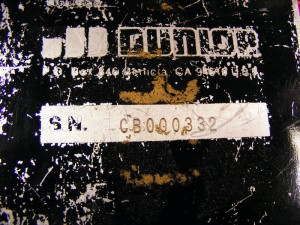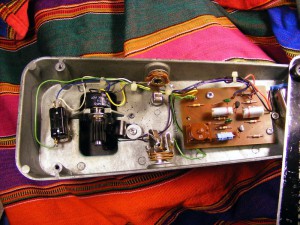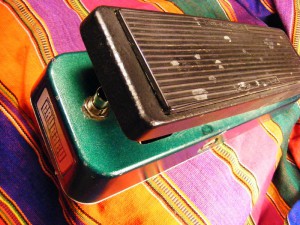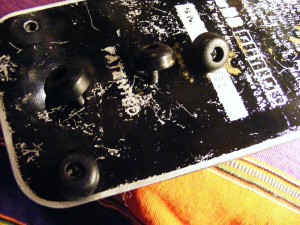This is a guest article by Joe Gagan, who also took and provided the pictures.
I am Joe Gagan. I buy hundreds of Dunlop wahs a year, from many sources. in 2013, a rare bird landed in my lap. Check it out: serial # CB000332. The earliest Dunlops I have seen start with ”CB”, but the 6 digit numbers usually show up much higher. And pretty soon the prefix became AA, AB and so on.
But first, a little background. Sometime around 1982, Jim Dunlop, a successful pick and capo manufacturer, started hearing from music stores that they were upset because they couldn’t get Crybabies, and customers still wanted them. This opportunity was too interesting! He did a little research, made a deal to buy the Crybaby brand and remaining parts without taking the whole Thomas Organ company, which at that time was a dying subsidiary of the Whirlpool Corp. Mr Dunlop has said that at the time he didn’t know how to make effect pedals, but he was damn sure going to learn!
During the earliest production years, many of the Thomas parts were still in use (see the photos, which are all of CB00332), such as the ”stack of dimes” inductor, original circuit board and foil caps, wiring and switch. NOTE: in the photos shown here, the pot is not original, nor is the green paint job.
The first things Dunlop changed were the front logo plate, a new bottom silkscreen, new wires tied with zip-ties instead of the quality wax-string harness tie of the Thomas wahs, crappy thin metal asian jacks, and a less than stellar battery clip. As the ’80s wore on and the original parts dwindled, the Crybaby entered a dark period wherein Dunlop experimented with cheaper parts and construction methods to raise profitability.
First, a terminal clip connector replaced the wire standoffs at the PCB.
Second, when it was time to re-order pots, Dunlop ordered Allen Bradley/Clarostat to shorten both the shaft AND bushing to save a few pennies. This new standard was given the name ”Hotpotz 1” and were also stamped ’Dunlop MFG’ on the side of the pot. Wisely, he had the pot maker retain the classic Crybaby taper, a recipe that has not changed, even through to 2015 and the by now 20 year old Hotpotz 2!
In ’83 or so a new PCB supplier was brought in, with weird traces and rapid revisions. Luckily, the stash of Stack-of-Dimes inductors lasted a few years. but when those were gone, the worst inductor in Crybaby history took its place. Foil caps gave way to miniature asian poly film. a nice cap, but not the mighty tone of the previous Thomas foils! The 5117 part number was retained for the transistors, but these babies do not have the character or even the tall size of the 70s 5117s.
Some items did not change from ’82 to late ’80s, though: the Carling SPDT switch, the wire color codes, the feet and feet-screws, the rubber treadle pad and the overall wah shell. Finishes on the shells varied in gloss, splatter level and quality, with gradual improvement to the process by the late ’80s.
Musicians began to realize that the ’85-’86 era Crybabies no longer sounded as good. Mr. Dunlop must have heard these rumblings, and the slow return to respectability was embarked upon.
To be continued… In part 2 I will explore the various ’86 thru ’91 changes, as Dunlop began to find its way to real quality.
About the author: Joe Gagan is a true wah pedal afficionado who manufactures and sells most things wah-related – from inductors and pots to kits and whole pedals. Hook up with him at facebook.com/WahWahByJoeGagan or visit his eBay store.




